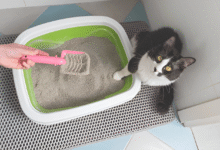
How to Tell If Your Pet Has Allergies: Signs & Treatments
Pet Has Allergies caused by itching or ear infections? Learn key signs & vet-approved treatments to relieve your dog or cat's discomfort fast.
Pet Has Allergies make your furry friend miserable, but recognizing the signs early can help you provide relief. Just like humans, pets develop Pet Has Allergies reactions to food, environmental factors, fleas, and even household products. Common symptoms include excessive scratching, red skin, ear infections, and digestive issues. If left untreated, these allergies can lead to more serious conditions like infections or chronic discomfort. Understanding the causes and symptoms is the first step in ensuring your pet stays happy and healthy.
Identifying Pet Has Allergies not always straightforward, as symptoms can mimic other health problems. Some pets may only show mild irritation, while others suffer from severe reactions. The key is observing changes in behavior, skin condition, and overall well-being. With the right knowledge and veterinary guidance, you can pinpoint the triggers and find effective treatments to help your pet feel better. This guide will walk you through the signs, causes, and best solutions for managing allergies in pets.
How to Tell If Your Pet Has Allergies
Common Signs Your Pet Has Allergies
One of the most noticeable symptoms of Pet Has Allergies is excessive scratching or licking. Pets may focus on their paws, ears, or belly, leading to redness and irritation. Unlike normal grooming, this behavior is persistent and often results in hair loss or hot spots. Another sign is recurrent ear infections, especially in dogs, which may indicate an underlying allergic reaction. Skin problems are another major indicator. Pets with allergies may develop rashes, hives, or scaly patches. These issues often arise from environmental allergens like pollen, dust mites, or mold. In some cases, pets may experience gastrointestinal symptoms such as vomiting or diarrhea, particularly with food allergies.
Types of Pet Has Allergies
Environmental Allergies
Environmental allergies, also known as atopic dermatitis, are triggered by substances like grass, pollen, or household cleaners. Pets with these allergies often show seasonal symptoms, worsening during high-pollen months. Indoor allergens, such as dust or mold, can cause year-round discomfort. Breeds like Golden Retrievers and Bulldogs are more prone to these reactions.
Food Allergies
Food allergies occur when a pet’s immune system reacts to certain ingredients, such as beef, chicken, or grains. Unlike food intolerances, which cause digestive upset, true allergies often lead to skin inflammation and chronic ear infections. An elimination diet supervised by a vet is the best way to diagnose food-related allergies.
Flea Allergy Dermatitis
Even a single flea bite can trigger flea allergy dermatitis in sensitive pets. This condition causes intense itching, particularly around the tail and hind legs. Regular flea prevention is essential to avoid flare-ups. If your pet is allergic to fleas, you may notice scabs or open sores from excessive scratching.
Diagnosing Pet Allergies
If you suspect your pet has allergies, a veterinary diagnosis is crucial. Vets may perform skin tests, blood tests, or elimination diets to pinpoint the cause. Intradermal testing, similar to human allergy tests, helps identify environmental triggers. For food allergies, a strict hypoallergenic diet is often recommended for 8–12 weeks. In some cases, secondary infections may complicate diagnosis. Bacterial or yeast infections can develop due to constant scratching, requiring antibiotics or antifungal treatments. Early diagnosis and treatment prevent long-term damage and improve your pet’s comfort.
Effective Treatments for Pet Allergies
Medications
Antihistamines, steroids, and immunotherapy (allergy shots) are common treatments. Antihistamines like Benadryl can provide relief but should only be used under veterinary guidance. Steroids reduce inflammation but may have side effects with long-term use. Immunotherapy is a long-term solution that gradually desensitizes pets to allergens.
Topical Treatments
Medicated shampoos, sprays, and ointments can soothe irritated skin. Oatmeal baths and hypoallergenic grooming products help reduce itching. For flea allergies, vet-approved flea control products are necessary to prevent infestations.
Dietary Changes
For food allergies, switching to a limited-ingredient or hydrolyzed protein diet can eliminate triggers. Always consult a vet before making dietary changes to ensure nutritional balance. Probiotics may also support gut health and reduce allergic reactions.
Environmental Modifications
Reducing exposure to allergens is key. Use air purifiers, wash pet bedding frequently, and avoid walking pets during high-pollen times. Regular cleaning minimizes dust and mold buildup in the home.
Preventing Allergies in Pets
Maintain a Clean Living Environment
Regularly vacuum carpets, wash pet bedding in hypoallergenic detergent, and use air purifiers to reduce dust mites, pollen, and mold spores. Minimizing exposure to these common environmental allergens can significantly lower your pet’s risk of reactions.
Implement a High-Quality Diet
Feed your pet a balanced, hypoallergenic diet free from common triggers like beef, chicken, wheat, and soy. If your pet has a history of food allergies, consult your vet about limited-ingredient or hydrolyzed protein diets to prevent flare-ups.
Use Flea and Tick Prevention Year-Round
Even one flea bite can trigger flea allergy dermatitis in sensitive pets. Use vet-approved flea preventatives (topical treatments, oral medications, or collars) and treat your home to eliminate infestations before they start.
Practice Regular Grooming & Skin Care
Frequent baths with oatmeal or medicated shampoos can remove allergens from your pet’s coat and soothe irritated skin. Brushing helps distribute natural oils and reduces dander, while ear cleaning prevents yeast and bacterial infections common in allergy-prone pets.
Choose Hypoallergenic Pet Products
Opt for fragrance-free, dye-free shampoos, cleaning sprays, and laundry detergents to avoid skin irritation. Avoid plastic food bowls (which can harbor bacteria) and instead use stainless steel or ceramic to reduce allergy risks.
Strengthen Your Pet’s Immune System
Supplements like omega-3 fatty acids, probiotics, and quercetin (a natural antihistamine) can support skin health and reduce inflammatory responses. Always consult your vet before adding new supplements.
Monitor Outdoor Exposure
Wipe your pet’s paws and coat after walks to remove pollen, grass, and outdoor allergens. During high-pollen seasons, limit outdoor time or choose early morning/late evening walks when allergen levels are lower.
Schedule Regular Vet Check-Ups
Early detection is key to managing pet allergies. Routine vet visits help identify sensitivities before they worsen, and your vet can recommend preventive treatments like allergy shots (immunotherapy) if needed.
Read More: How to Stop Cat Scratching (Without Declawing)
Conclusion
Pet Has Allergies can significantly impact your furry companion’s quality of life, but with proper care and attention, they can be managed effectively. By recognizing the signs such as excessive scratching, skin irritation, or digestive issues you can take swift action to provide relief. Consulting your veterinarian for an accurate diagnosis ensures your pet receives the right treatment, whether through medication, dietary changes, or environmental adjustments.
Managing Pet Has Allergies is an ongoing process that requires patience and consistency. With the right approach including preventive measures like hypoallergenic diets, regular grooming, and flea control you can minimize discomfort and keep your pet happy. Remember, early intervention is key to preventing more serious complications. By staying observant and working closely with your vet, you can help your Pet Has Allergies live a comfortable, allergy-free life.
FAQs
What are the most common signs of Pet Has Allergies?
Excessive scratching, red/inflamed skin, chronic ear infections, sneezing, and gastrointestinal upset are key indicators of Pet Has Allergies.
Can develop seasonal Pet Has Allergies like humans?
Yes, many pets suffer from seasonal allergies triggered by pollen, grass, or mold, often showing worse symptoms in spring and fall.
How are food allergies diagnosed in pets?
Vets typically recommend an elimination diet, where potential allergens are removed and slowly reintroduced to identify triggers.
Are certain breeds more prone to allergies?
Breeds like Bulldogs, Retrievers, and Terriers have higher genetic predispositions to skin and food allergies.
What’s the fastest way to relieve my pet’s allergy symptoms?
Consult your vet for antihistamines, medicated shampoos, or allergy shots, while removing exposure to known allergens.







